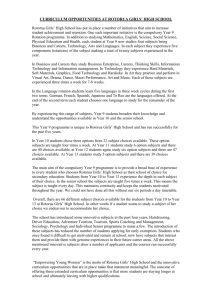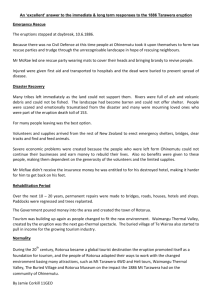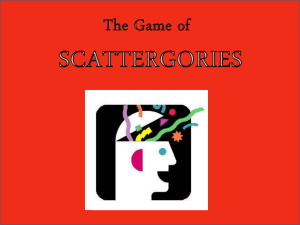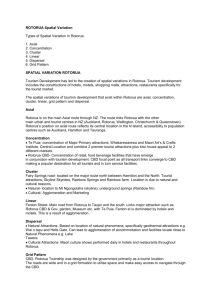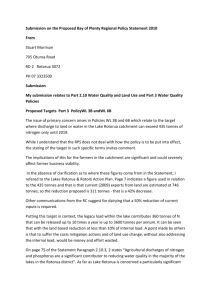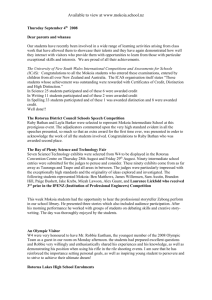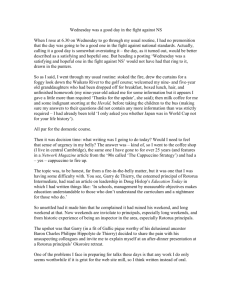P o s i
advertisement
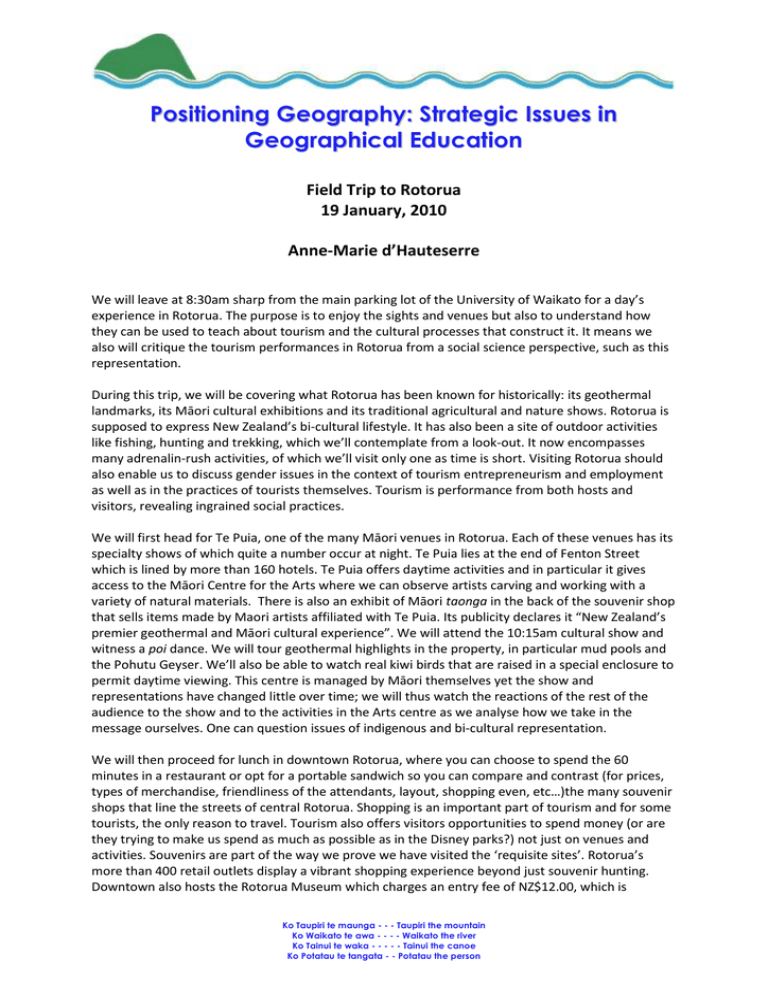
Positioning Geography: Strategic Issues in Geographical Education Field Trip to Rotorua 19 January, 2010 Anne-Marie d’Hauteserre We will leave at 8:30am sharp from the main parking lot of the University of Waikato for a day’s experience in Rotorua. The purpose is to enjoy the sights and venues but also to understand how they can be used to teach about tourism and the cultural processes that construct it. It means we also will critique the tourism performances in Rotorua from a social science perspective, such as this representation. During this trip, we will be covering what Rotorua has been known for historically: its geothermal landmarks, its Māori cultural exhibitions and its traditional agricultural and nature shows. Rotorua is supposed to express New Zealand’s bi-cultural lifestyle. It has also been a site of outdoor activities like fishing, hunting and trekking, which we’ll contemplate from a look-out. It now encompasses many adrenalin-rush activities, of which we’ll visit only one as time is short. Visiting Rotorua should also enable us to discuss gender issues in the context of tourism entrepreneurism and employment as well as in the practices of tourists themselves. Tourism is performance from both hosts and visitors, revealing ingrained social practices. We will first head for Te Puia, one of the many Māori venues in Rotorua. Each of these venues has its specialty shows of which quite a number occur at night. Te Puia lies at the end of Fenton Street which is lined by more than 160 hotels. Te Puia offers daytime activities and in particular it gives access to the Māori Centre for the Arts where we can observe artists carving and working with a variety of natural materials. There is also an exhibit of Māori taonga in the back of the souvenir shop that sells items made by Maori artists affiliated with Te Puia. Its publicity declares it “New Zealand’s premier geothermal and Māori cultural experience”. We will attend the 10:15am cultural show and witness a poi dance. We will tour geothermal highlights in the property, in particular mud pools and the Pohutu Geyser. We’ll also be able to watch real kiwi birds that are raised in a special enclosure to permit daytime viewing. This centre is managed by Māori themselves yet the show and representations have changed little over time; we will thus watch the reactions of the rest of the audience to the show and to the activities in the Arts centre as we analyse how we take in the message ourselves. One can question issues of indigenous and bi-cultural representation. We will then proceed for lunch in downtown Rotorua, where you can choose to spend the 60 minutes in a restaurant or opt for a portable sandwich so you can compare and contrast (for prices, types of merchandise, friendliness of the attendants, layout, shopping even, etc…)the many souvenir shops that line the streets of central Rotorua. Shopping is an important part of tourism and for some tourists, the only reason to travel. Tourism also offers visitors opportunities to spend money (or are they trying to make us spend as much as possible as in the Disney parks?) not just on venues and activities. Souvenirs are part of the way we prove we have visited the ‘requisite sites’. Rotorua’s more than 400 retail outlets display a vibrant shopping experience beyond just souvenir hunting. Downtown also hosts the Rotorua Museum which charges an entry fee of NZ$12.00, which is Ko Taupiri te maunga - - - Taupiri the mountain Ko Waikato te awa - - - - Waikato the river Ko Tainui te waka - - - - - Tainui the canoe Ko Potatau te tangata - - Potatau the person additional. You are most welcome to visit the museum if you prefer. One can cover most of the important exhibits in an hour. At 13:30 (1:30pm) we will drive to a look out at the top of Mount Ngongotaha to gain a different perspective on Rotorua (you can eat your portable sandwich on the way up and at the top if you got too busy downtown). The city has been built in a 60km wide caldera which has become the site of a multitude of outdoor activities both to test your fitness and also entrepreneurs’ and your prowess with new technologies (e.g. nzone, the ultimate jump). Many of these activities occur in and around the lakes: fishing and boating, as well as leisurely cruising, but also along its rivers (rafting, jetboating and sledging) and its bushes (hunting, trekking, mountain biking). These last can enable one to discover some of the still existing Indigenous forests (at Te Urewera or Whirinaki, for example) thanks to local Māori guides. Some of the geo-thermal nature has been tamed in the form of feepaying spas and mud baths (e.g. Hell’s Gate, Polynesian Spas, but also private spas and small individual pools in many of the hotels that line Fenton Street) to the detriment of some of the more publicly visible areas. One can practice golf, horse riding and mini-golf. Less environmentally friendly off-road adventures are for sale too. We might also hear helicopters that take people to active volcanoes or fly over the stunning lakes, thermal reserves and waterfalls of the area. All these activities should lead us to ponder about the sustainability of tourism. Rotorua does have a sustainable tourism charter (and makes yearly assessments to insure that businesses improve their sustainability performance) but not every business adheres. It also asks that we play our part: ‘a sustainable visitor destination exists not only on the actions of the host community but also on the actions of its visitors’. Which visitors are addressed: international ones or domestic ones, or both? Which actions need to be sustainable since, obviously, getting there is not really an area to question. Should it be? Te Puia has a Qualmark qualification, Agrodome has both. We now head for the Agrodome, ‘the world of the New Zealand farmer: a unique New Zealand experience’. It is not a farm show. Representation and obfuscation are two great themes to explore through this exhibit during which we need to watch more closely gender issues too. We are booked for the 14:30 (2:30pm) show and its live exhibits (the main actors are the animals, hence its appeal to all ages), including sheep shearing, a very ‘male’ activity? It is followed by a short display of sheep mustering by the dogs, outside. Questioning the use of animals for the entertainment of visitors is another fruitful area of enquiry and critique. The site boasts a Woollen Mill where one can witness wool carding and spinning after the show. It is one of the earlier activities offered by Rotorua, together with Whakarewarewa (the other half of Te-Puia) and Rainbow Springs. It is very popular with Asian visitors, especially urban ones; much less so with visitors from the UK. It has a souvenir shop that sells sheep skins and clothing items, mostly. One can pet the lambs that are kept in an enclosure just off the main hall, accessible to the public. On the way out we’ll make a stop at the Zorb ‘globe riding’, one of the many new activities that local entrepreneurs have set up but that have little link to the place they are located in… except that they provide an income for the entrepreneur and contribute to maintaining the flow of visitors to the area. Zorb does boast a Qualmark qualification and is a member of the Rotorua Sustainability Charter. Some of such activities may have been created to entertain domestic tourists or residents who accompany their international friends to destinations like Rotorua whose traditional venues they feel they have become a bit too familiar with? Here, as for the Museum, you are welcome to participate for an extra fee of NZ$44 per roll-down (which lasts less than a minute): this is the wet one, less punishing on the body. It is recommended you bring a swim suit for it, though. The dry roll costs NZ$53 but could leave you bruised. We can also just contemplate some of the people who have dared before we dash off to Mamaku Blue (they close at 17:00) for those who have a sweet tooth and want to enjoy blueberries on the trip back to Hamilton. Mamaku is not far from the Agrodome and on the way to Hamilton. Its theme and main activity are based on blueberries. Ko Taupiri te maunga - - - Taupiri the mountain Ko Waikato te awa - - - - Waikato the river Ko Tainui te waka - - - - - Tainui the canoe Ko Potatau te tangata - - Potatau the person
